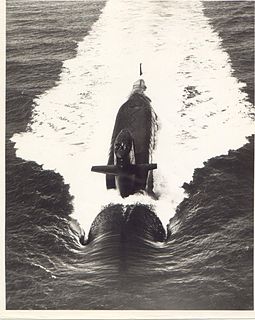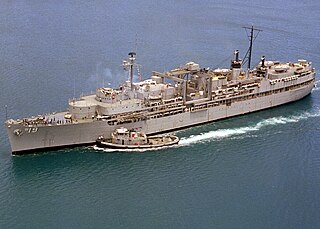
USS Patrick Henry (SSBN-599), named after the American Revolutionary War figure Patrick Henry (1736–1799), was a George Washington class nuclear-powered fleet ballistic missile submarine of the United States Navy. She was later converted into an attack submarine and redesignated SSN-599.

USS Theodore Roosevelt (SSBN-600), a George Washington-class submarine, was the second ship of the United States Navy to be named for President Theodore Roosevelt (1858–1919). Initially unnamed and assigned hull classification symbol SSGN-600 as a guided missile submarine, her keel was laid down on 20 May 1958 by the Mare Island Naval Shipyard using components initially assembled for the Skipjack-class submarine nuclear attack submarine USS Scamp (SSN-588). She was named Theodore Roosevelt and redesignated fleet ballistic missile submarine SSBN-600 on 6 November 1958, launched on 3 October 1959 sponsored by Mrs. Alice Roosevelt Longworth (1884–1980), daughter of the ship's namesake, and commissioned on 13 February 1961 with Commander William E. Sims commanding the Blue Crew and Commander Oliver H. Perry, Jr. commanding the Gold Crew.

USS Robert E. Lee (SSBN-601), a George Washington-class fleet ballistic missile submarine, was the only ship of the United States Navy to be named for Robert E. Lee (1807–1870), the commanding general of the Confederate forces during the American Civil War.

USS Abraham Lincoln (SSBN-602), a George Washington-class fleet ballistic missile submarine, was the first ship of the United States Navy to be named for Abraham Lincoln (1809–1865), the 16th President of the United States (1861–1865).

USS Lafayette (SSBN-616), the lead ship of her class of ballistic missile submarine, was the third ship of the United States Navy to be named to honor Gilbert du Motier, Marquis de Lafayette, a French military hero who fought alongside and significantly aided the Continental Army during the American Revolutionary War.

USS John Marshall (SSBN-611) was an Ethan Allen-class submarine, the only ship of the United States Navy to be named for John Marshall (1755–1835), the fourth Chief Justice of the United States. Originally a fleet ballistic missile submarine designated SSBN-611, she later was reclassified as an attack submarine and re-designated SSN-611.

USS Will Rogers (SSBN-659) was a Benjamin Franklin-class ballistic missile submarine – the last of the "41 for Freedom" Polaris submarines. She was the only ship of the United States Navy to be named for humorist Will Rogers (1879–1935).

The Holy Loch is a sea loch, a part of the Cowal peninsula coast of the Firth of Clyde, in Argyll and Bute, Scotland.

The third USS Proteus (AS-19) was a Fulton-class submarine tender in the United States Navy.

USS Betelgeuse (AK-260) was the last of the cargo ships in service in the United States Navy. On 10 April 1944, it was renamed the SS Colombia Victory after being launched as a Victory ship to carry cargo during World War II. She was transferred to the US Navy in 1951.

ABSD-7, an advanced base sectional dock, was constructed of seven advance base docks (ABD) as follows: ABD-37, ABD-38, ABD-39, and ABD-40 were built by Chicago Bridge & Iron Company, Morgan City, Louisiana, and completed in December 1944 and January and February 1945; ABD-51 and ABD-52 were built by Pollock-Stockton Shipbuilding Company, Stockton, California, and completed in January and March 1945; and ABD-58 was built by Pittsburgh-Des Moines Steel Co., Pittsburgh, Pennsylvania, and completed in October 1944.

USS Daniel Webster (SSBN-626), a Lafayette-class ballistic missile submarine (FBM), was the only ship of the United States Navy to be named for Senator Daniel Webster.

USS George C. Marshall (SSBN-654), a Benjamin Franklin-class ballistic missile submarine, was the only ship of the United States Navy to be named for General of the Army George C. Marshall (1880-1959), who served as U.S. Secretary of State from 1947 to 1949 and as U.S. Secretary of Defense from 1950 to 1951.

USS Canopus (AS-34) was a Simon Lake-class submarine tender of the United States Navy, operational from 1965 to 1994. The vessel was used to repair and refit submarine-launched Polaris nuclear-armed ballistic missiles and the submarines that deployed with them. The vessel primarily served US naval bases on the US Atlantic Coast and in Europe. In 1969, the ship was overhauled to maintain the new Poseidon Missile Systems. Taken out of service in 1995, the US Navy's intent to have the ship broken up for scrap in the United Kingdom was controversial. By 2010 demolition had been completed.

A depot ship is an auxiliary ship used as a mobile or fixed base for submarines, destroyers, minesweepers, fast attack craft, landing craft, or other small ships with similarly limited space for maintenance equipment and crew dining, berthing and relaxation. Depot ships may be identified as tenders in American English. Depot ships may be specifically designed for their purpose or be converted from another purpose.

USS Hunley (AS-31) was a submarine tender of the United States Navy launched on 28 September 1961 and commissioned 16 June 1962. The Hunley was designed to tend most of the long-term requirements of the Polaris Class of submarines. The ship achieved several records and milestones in its service. The Hunley was decommissioned from the regular navy, in 1995 transferred to the US Maritime Commission, and in 2007 sold as scrap to a metal recycling company in Louisiana. In September 2008, during Hurricane Gustav, the decommissioned ship broke free of its moorings in the New Orleans Inner Harbor, but caused little or no damage while adrift.

USS Alcor, AK-259, was a Greenville Victory-class cargo ship in service with the United States Navy from 1952 to 1968. She was originally built in 1944 as SS Rockland Victory, a World War II era Victory ship. She was sold for scrap in 1970.

Submarine Squadron 15 is a squadron of submarines of the United States Navy based at Naval Base Guam.
Everett-Pacific Shipbuilding & Dry Dock Company was established in 1942 to build ships needed for World War II. As part of the Emergency Shipbuilding Program the US Navy provided some of the capital to start Everett-Pacific Shipbuilding at Port Gardner Bay in Everett, Washington. Everett-Pacific was sold in 1945 to the Pacific Car and Foundry, who was already a major manufacturer of railcars and trucks. Pacific Car and Foundry was building barges for the US Navy during World War II at plants in Renton, Seattle and Tacoma in the state of Washington. The lease for the shipyard in Everett, Washington ended in 1949 and the yard closed. Pacific Car and Foundry in 1972 changed its name to Paccar Inc. to reflect its major products. The Everett-Pacific shipyard site later became part of Western Gear, a heavy machinery manufacturer. in 1987 the shipyard became part of Naval Station Everett. Everett-Pacific Shipbuilding was started by William Pigott Jr. a Seattle businessmen and his brother Paul Pigott (1900-1961). William Pigott Jr. was born in 26 Aug. 1895 in Pueblo, CO and died on 8 July 1947 in San Francisco, CA.
Pollock-Stockton Shipbuilding Company was established in 1942 to build ships needed for World War II. As part of the Emergency Shipbuilding Program the US Navy provided some of the capital to start Pollock-Stockton Shipbuilding at Stockton, California. The shipyard was located at San Joaquin River and Stockton Channel, near Louis Park. After the war the shipyard closed down in February 1946.



















